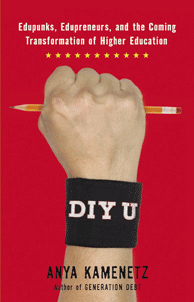The Moral Mission
Author Anya Kamenetz talks to CT about the institutional imperative to bring down tuition costs and make higher learning more accessible to more people.
Above photo of Anya Kamenetz by Jayd Gardina
DIY U: Edupunks, Edupreneurs, and the Coming Transformation of Higher Education (Chelsea Green Publishing, 2010) explores how students can and will use technology to sidestep the spiraling costs of college to pursue non-traditional paths toward learning. Author Anya Kamenetz talks to CT about the institutional imperative to bring down tuition costs and make higher learning more accessible to more people.
Campus Technology: In the book you show how technology-enabled instruction can bring down the costs of education while at the same time making it more effective. So why isn’t everyone doing it?
Kamenetz: Administration and the technology office are [often] working at cross-purposes. The technology office says, “Oh, we need this new technology,” and the administration says, “Oh no, we need to cut costs.” The conversation can completely change if the technology officer says, “Here’s how we are going to use technology to cut costs and improve learning. And we’re going to track it because we care about cutting costs, because cutting costs means making education available to more people.”

DIY U: Edupunks, Edupreneurs, and the Coming Transformation of Higher Education
They should be most worried that their institutions are going to fall into a defensive crouch when it comes to the truly transformative potential of technology to change the quality of higher education in the United States and to make it more available to more people.
What should they be most excited about?
I think they should be extremely excited about how technology can help change their own professional practices, to help them with their development, to expand their communities, and to involve more of the world, which is truly some of the best work that anyone could be doing right now.
What should they be doing right now that they may not be doing?
What they could be doing more of is making the moral case for
innovation. Often there’s a siloing that occurs. Faculty who are very forward-looking in adopting technological practices [get] very excited about what it can do for their own teaching and learning, but they maybe don’t make the larger connection of how we can use this technology to bring education to more people at a lower cost and to really serve our mission. Not only our mission of teaching students, but our mission of lowering our costs and making this more accessible to more people.